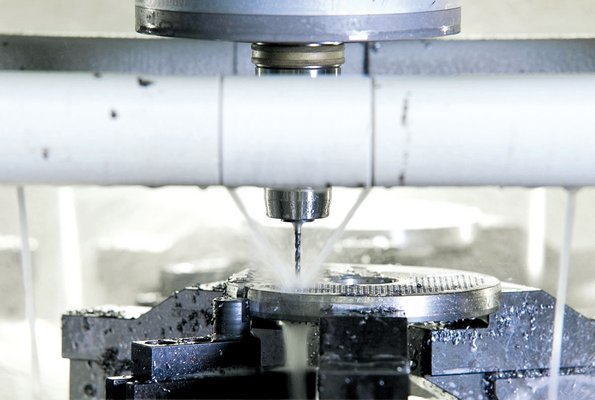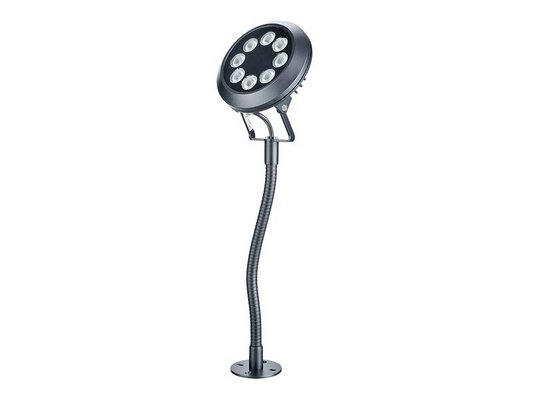Whether signal light, pick-to-light system, workplace or machine illumination – LED lights conquer more and more industrial fields of application.
LED lights are more robust, energy efficient and long-lasting than other illuminants. That is reason enough for automation specialist Turck to expand their portfolio with LED machine and workplace lights that are connectable to the controls or fieldbus junction boxes via M12 connectors.
With the EG-regulation 244/2009, the European Union started to phase out the classical light bulb. This has generated the need to replace these bulbs with alternative light sources. The latest step of the regulation occurred in September 2011; since then luminous elements above 60 Watt have to meet the energy efficiency class C, accordingly 60 Watt bulb must meet class E standards. Basically it means light bulbs with more than 40 Watt will not be used much longer.
Everyday users are not happy about this, wanting the old light bulbs back, complimenting their warm light and complaining about the disadvantages of the energy saving lamp. Some of the disadvantages include complicated disposal and the delay in reaching the full luminous intensity. Despite the genius inventor of the classic light bulb, Thomas Edison, the functionality of the classic bulb is very archaic. The design allows electricity through an electric conductor until it heats up and begins to glow, radiating light – rather bright but not very energy efficient. The ratio of visible light is only up to five percent from the total energy consumption.
Because of the new energy savings, LED lights are quickly taking the place of the classic light bulb. The LED technology from Edison’s heirs is so well engineered that it is already established in niche areas and conquering more and more shares in the market. LED’s are already being used in traffic lights, street lights and medical engineering applications, as well as mainstream applications including flashlights and bicycle lamps. Each of the specific characteristics of LED is an advantage for those areas of application: the energy efficiency, the precise light color and the long life span of about 100,000 hours are features that outmatch other illuminators.
In the industrial environment, the LED technology has already been used for status and signal lights for a some time. The difference between traditional bulbs is that the light emitting diodes is that they are not thermal emitters. LED’s emit almost monochrome light in a limited spectral range. That is why they are so efficient compared to other illuminants, where color filters have to filter a large part of the spectrum to reach monochrome color characteristics. Next to these advantages the LED also thrives in rough environmental conditions because it is very robust and highly resistant to vibrations.
Robust lighting portfolio
Turck uses the advantages of the LED for a comprehensive LED lighting technology portfolio; in addition to traditional uses, users also can find LED industrial lamps for machines and workplaces. Most LED lights come from Turck’s partner Banner Engineering, but the machine lights are being developed and produced by Turck.
Signal lights are usually used for displaying the status of systems, machines or process stages. For such start and stop signals or traffic light signals, the high light intensity of the LED pays off and bright signal lights can be seen in a minimum amount of space. One type of signal light is the pick-to-light system where Turck is one of the market leaders. Pick-to-light solutions show the installation sequence in manual production and packing processes. The LED light shows the assembler the specific product configuration with light signals at the output trays. The assembler simply takes a component from the illuminated tray and installs it. The signal light has an integrated light sensor that confirms the removal of a component automatically. The signal lights are connected via Turcks I/O systems BL20 or BL67 and controlled with the integrated CoDeSys-programmable gateway or by the superior SPS. To connect the system to the automation structure of the user, the I/O system offers numerous gateways for the common fieldbus and ethernet solutions.
LED machine lighting
LED isn’t only suitable as a signal light for industrial environments, it also has its advantages as a light source. For this reason LED machine and workplace light fixtures complete the Turck portfolio. The housing materials and the construction principle are the same as sensors. The lamps are moulded and resistant from common solid cooling lubricants such as oils and aggressive cleansing materials. This technology provides a decrease in susceptibility to malfunctioning and allows longer life spans.
LED machine lights can be connected directly with a M12 connector to a standard SPS output, a fieldbus station or a passive junction. They are supplied with 24 VDC and have a power consumption of less than 0,5 A. Over an SPS or a programmable fieldbus gateway from Turck, the illumination can be controlled externally depending on other control variables. This option makes the installation easier and offers new possibilities to save energy. Instead of using a permanent illumination of 100 percent, individual illumination scenarios regarding production step, product, needed brightness and other parameters are programmable. The reduced wiring effort of the M12 connector is an additional bonus. The machine lights are available as built-in longitudinal light as well as surface mount, and beacon and cube light, with or without a gooseneck for easier alignment.
LED workplace illumination
If you want to abstain from expensive protective housings, LED lights are often the only option for illumination in close proximity to machines where they are exposed to dirt, dust, steam or aggressive cleansing materials. The use of LED in the production environment is possible because they are robust (protection category IP67) and shock resistant. The color temperature of the LED in the daylight areas is between 5,000 and 10,000 Kelvin. The luminous flux lies between 65 and 1,800 lumen, depending on the type. As a comparison a 100-Watt light bulb has a luminous flux of about 1,400 lumen, a 60-Watt light bulb about 700. The switching on/off of the lights happens over the connection with the needed supply voltage (10...30 VDC) or – when there is a constant power supply – over the integrated switch at the LED light.
The lights are available in three types: As compact spot light, as longitudinal light and as square LED light for extensive light requirements. Each work area can be illuminated optimal with luminous flux of 65 up to 1,800 lumen. The spot lights with six LED’s are available with or without a switch. The longitudinal lights are offered in eight different versions of three up to 24 LED’s, with or without a switch. For the extensive illumination of large work areas Turck offers four square LED lamps with twelve up to 48 LED’s.
Conclusion
With their life span of about 100,000 hours, LED lights increase the availability of machines and reduce maintenance costs. Design engineers and plant designers will prefer the installation of LED lights in the future, especially with illuminants that are difficult to access. The LED light will also be established for private use soon. Design, light color, purchase price and most of all the power consumption will be the main factors for its use.
In 2016, the last step of the EG-regulation will be carried out: all lamps (with the exception of a few halogen lights) have to meet the energy efficiency class B. Common light bulbs and normal halogen lamps will then be completely phased out. Next to the energy efficient lamps, a broad spectrum of LED lights will be available and established as the superior technology. It remains to be seen if the scenarios of illuminated walls with the use of OLEDs (Organic Light Emitting Diodes) will turn into reality or not. With OLED and its organic luminous material the circle will be complete as the filament of Edison’s improved light bulb from 1880 was made of charred bamboo fibers.
Author
Markus Bregulla is the product manager for opto- and ultrasonic sensors at Turck Germany in Mülheim
Download the complete article (PDF, 600KB).
More information on Turck under:
www.turck.de









![[Translate to English:] Signalleuchten
Pick-to-Light-Lösungen
LED-Industrieleuchten [Translate to English:] Signalleuchten werden zur Anzeige von System- oder Maschinenzuständen oder Prozessabschnitten eingesetzt.
Pick-to-Light-Lösungen: Leuchten zur Anzeige von Montageabfolgen.
LED-Industrieleuchten für Maschinen und Arbeitsplätze.](/fileadmin/_processed_/8/e/csm_AG_Turck_DirekteSteuerung_1_21bacb7747.jpg)

